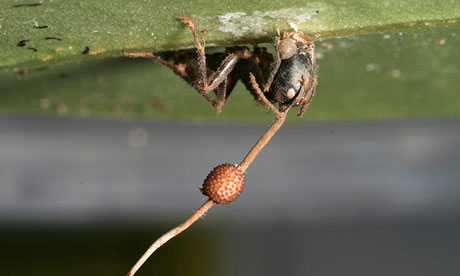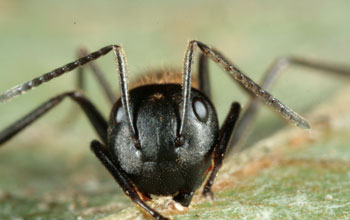Form and Function
Prominent features of Ophiocordyceps
unilateralis include the formation of a stalk from the base of an ant host’s
head, as well as the spread of mycelium throughout the host body’s muscle
and brain tissue. Yeast-like growth of this fungus throughout the body of
its host does not invade host cells but rather works around them and spreads
the tissue apart. According to recent research, dissection of ants in post
death-grip positions revealed signs of muscle atrophy of the mandibular
muscles along with hyphal body growth indicative of ants infected by
Ophiocordyceps unilateralis (Hughes 2011).

Complex adaptations to a particular host are a hallmark of specialized
parasites. The manipulation of behavior by the parasitic fungus
Ophiocordyceps unilateralis upon the Camponotus leonardi ant is suggestive
of such an adaptation (Hughes 2011). Worker ants on the forest floor pick up spores
dispersed by a mature fungus, allowing the spore to secrete enzymes and
enter the host’s body (Evans, et al. 2011). Once inside, the fungus begins to spread throughout
the ant’s body and head, occupying muscle tissue and cavities (figure).
When the fungus makes an established foothold in the ant’s body, it is able
to manipulate its host’s body to increase its own fitness. In more specific
terms this relationship is an example of an extended phenotype, which is
defined by Dawkins as the capacity of an individual or group of parasites to
manipulate host behavior to improve fitness (Dawkins 1982).

It is suggested that the invading fungus, through the use of extended
phenotypes and mechanisms, is able to cue for a specific form of behavior as
has been observed by researchers who timed the death-grip bite of infected
ants around the noon hour (Hughes 2011). These adaptations to manipulate behavior are
essential in directing the host to an environment that promotes optimal
growth. Though these mechanisms are not well known, it is believed that the
parasitic fungus produces compounds that allow it to direct the host to
perform an action (Evans, et al. 2011). Some of these adaptations, such as the use of clock genes
to synchronize behavior are commonly found in other fungi (Hughes 2011). It is interesting
to consider what might happen when scientists eventually discover what
chemical or pathways the fungus utilizes to control behavior in its host to
be both horrifying and beneficial.